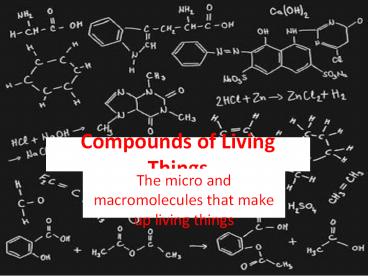Compounds of Living Things - PowerPoint PPT Presentation
Title:
Compounds of Living Things
Description:
Compounds of Living Things The micro and macromolecules that make up living things All compounds are classified as either: Organic Compounds: Contain Carbon Ex: Human ... – PowerPoint PPT presentation
Number of Views:98
Avg rating:3.0/5.0
Title: Compounds of Living Things
1
Compounds of Living Things
- The micro and macromolecules that make up living
things
2
All compounds are classified as either
- Organic Compounds
- Contain Carbon
- Ex Human beings, DNA, Proteins
- B. Inorganic Compounds
- do not contain carbon (except CO2)
- Ex Water, salt, soil
3
Linking two or more Compounds Together
- Polymerization!!
- Definition
- taking smaller compounds and joining them
together to make bigger compounds
4
The Four Compounds of Life
- Carbohydrates
- Lipids
- Proteins
- Nucleic Acids
- all are organic AND carbon-containing
All contain two or more of 4 elements Hydrogen,
Oxygen, Carbon, and Nitrogen
5
1. Carbohydrates
- Discuss with your table partner about where you
have heard this term before
6
1. Carbohydrates
- Made up of Carbon, Hydrogen, Oxygen (121
ratio) - Used as energy!!
7
1. Carbohydrates (continued)
- Sugars and starches
- Simple sugars monosaccharides
- Ex glucose
- Two simple sugars disaccharides
- Complex sugars polysaccharides
8
Linking two or more simple sugars
- Known as Dehydration Synthesis
- Definition Linking two simple sugars together by
removing a water molecule
9
Breaking two or more simple sugars
- Known as HYDROLYSIS
- Definiton Breaking two simple sugars apart by
adding in a water molecule
10
The Two Work Together.
11
2. Lipids
- Discuss with your table partner about where you
have heard this term before
12
2. Lipids
- Organic compounds that are waxy and oily
- Are used to store energy, form biological
membranes, and as chemical messengers - Often formed by a glycerol molecule combining
with fatty acids
13
3. Proteins
- Discuss with your table partner about where you
have heard this term before
14
3. Proteins
- Organic compounds that contain nitrogen in
addition to carbon, hydrogen, and oxygen - Made up of building blocks called amino acids
- Amino acids are linked together (via dehydration
synthesis) by a covalent bond known as a peptide
bond
15
Amino Acids
16
20 Amino Acids
17
Proteins are so multi-functional
- Carry out chemical reactions (enzymes)
- Pump small molecules in and out of cells
(membrane proteins) - Cell Movement (cilia and flagella)
18
Enzymes
- The most major class of proteins
- Catalysts speed up the rate of a chemical
reaction - Not changed by the reaction
- Lower the start-up energy required for
reactions - Substrates bind to active sites that are
extremely specific!
19
4. Nucleic Acid
- Discuss with your table partner about where you
have heard this term before
20
4. Nucleic Acids
- Large, complex organic molecules composed of
carbon, oxygen, hydrogen, nitrogen, and
phosphorous atoms - Two kinds RNA and DNA
- Both store and transmit genetic information
21
4. Nucleic Acids (continued)
- Building blocks of these polymers are called
nucleotides - nucleotides contain
- three parts
- Nitrogen base
- A phosphate group
- 5-carbon sugar
- Nucleotides are linked together by covalent bonds
to form Nucleic Acids
22
With your notes and Chap 2-3 fill out the chart
the best you can
Compound of life Made of Monomers polymers
1.
2.
3.
4.
Monosaccharide Ex glucose, fructose, galactose
Polysaccharides ex starches, complex sugars
carbohydrates
CHO
Fatty acids and glycerol
Waxes, fats, oils, steroids
CHO
lipids
Chains of amino acids Muscle proteins
HONC
Amino Acids
protein
DNA RNA
Nucleic Acid
PONCH
nucleotides
I Call this the Cho-cho-honc-ponch chart to help
you organize and remember the 4 compounds of life.































